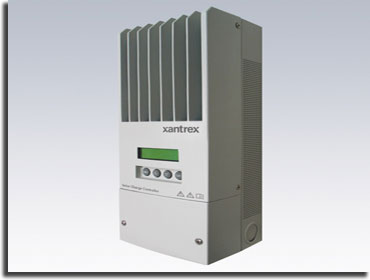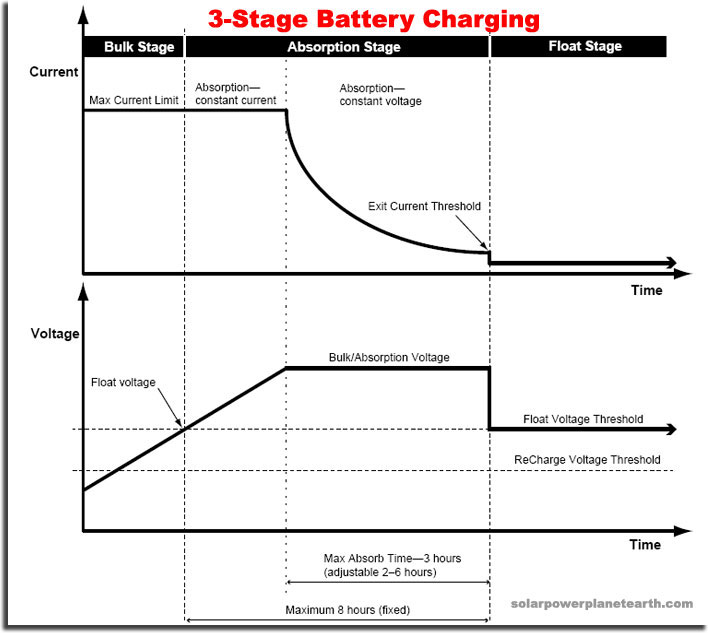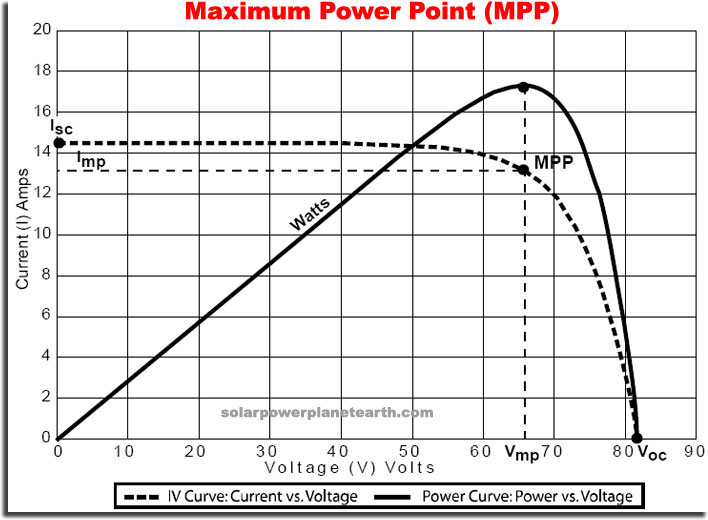 |
Solar Power Charge Controllers
A solar charge controller is needed only when an off-grid or hybrid solar system is installed. These two types of systems utilize batteries, which are charged and discharged daily. It is the charge controllers responsibility to regulate the charging of the batteries from the photovoltaic panels in order to maximize the life of the batteries, and to ensure maximum power is transfered from the PV array to the batteries.
Why Can't the Photovoltaic Panels be Wired Directly to the Batteries?
Your battery array voltage is going to be different than the voltage produced by your PV array. Let's say you have a 48VDC battery bank and a 650W PV array that has a max power output of 10A at 65VDC. If we were to wire this directly to the batteries, the batteries would "pull" the PV array voltage down to 48VDC. This means the PV array is now pushing 10A at 48VDC into the batteries, and not 10A at 65VDC. You may ask, why does this matter, 10A is 10A right? No! If you recall from our electricity 101 tutorial that power equals voltage times current. In other words, we are going to go from 65VDCx10A=650W, to 48VDCx10A=480W. In this scenario, you are loosing 170W (650W-480W), which equals 26% of the power your photovoltaic panels are producing. A charge controller will allow you to step down the voltage coming from the solar panels, without loosing this power. It does this by reducing the voltage, but increasing the current. So for our example above, it would go from 10A at 65VDC to 13.54A at 48VDC, giving you 48VDC x 13.54A = 650W. Make sense? If not, see our electricity 101 tutorial for an explanation of voltage, current, and power.
How are Charge Controllers Characterized?
The following table contains the typical parameters given on a charge controller data sheet. This data is from the Xantrex XW-MPPT60-150 Solar Charge Controller.
| Nominal battery voltage | 12, 24, 36, 48, 60 Vdc |
|---|---|
| Maximum PV array voltage (operating) | 140 Vdc |
| Maximum PV array open circuit voltage | 150 Vdc |
| Array short-circuit current | 60 Adc maximum |
| Maximum and minimum wire size in conduit | #6 AWG to #14 AWG |
| Total power consumption while operating | 2.5 W |
| Charger regulation method | Three-stage (bulk, absorption, float) Two-stage (bulk, absorption) |
| Dimensions (H x W x D) | 14.5x5.75x5.5" (368x146x138mm) |
| Weight (controller only) | 10.75lb (4.8kg) |
| Mounting | Vertical wall mount |
| Standard warranty | Five years (10 years optional) |
| Enclosure type | Indoor, ventilated, aluminum heat sink |
| Operating temperature range (full power) | -4 to 113F (-20 to +45C) |
| Storage temperature | -40 to 185F (-40 to +85C) |
| Altitude limit (operating) | Sea level to 15,000ft (4572m) @ 15C |
Nominal Battery Voltage
These are the array voltages at which the charge controller will work with.
Max. PV Array Voltage (operating)
This is the maximum PV array voltage that can be present at the input of the charge controller while under full power operation.
Max. PV Array Open Circuit Voltage
This is the maximum PV array voltage that can be present at the input of the charge controller when no power is flowing from the PV array, i.e. open circuit.
Array Short-Circuit Current
This is the maximum current that the charge controller will accept, and is best rated at the PV array short-circuit cuurent.
Maximum and Minimum Wire Size in Conduit
This is the range of wire sizes that can be used to make connections to the charge controller.
Total Power Consumption While Operating
This is the amount of power that the charge controller needs to operate. This power can be considered power lost, and is not transfered to the output.
Charge Regulation Method
This is how the charge controller regulates the battery charging. This is best described through a plot of charging over time. The following plot shows a voltage and current plot over time for a 3-stage charging cycle. A two stage cycle would be identical, just lacking the third or "float" stage.

Remember, as mentioned previously, this method of charging is designed to maximize battery life. To better understand this, see our page on deep-cycle batteries.
Dimensions
Height, width, and depth of the charge controller unit.
Weight
Weight of the charge controller in pounds and kilograms.
Mounting
How the charge controller is mouted.
Standard Warranty
The time duration of the manufacturer's warranty.
Enclosure Type
Type of physical enclosure that the charge controller unit is housed in.
Operating Temperature Range (full power)
Range of temperatures at which the charge controller can operate while at full power.
Storage Temperature
Temperature range at which the charge controller must be stored at when not in use.
Altitude Limit
The maximum altitude at which the charge controller can operate at a given temperature. This limitation is due to the decreasing density of air as you increase in elevation, which reduces the ability of the charge controller to dissapate heat through convection.
Maximum Power Point Tracking (MMPT)
In order to extract the maximum power of the photovoltaic array at all times, Maximum Power Point Tracking (MPPT) is used. As the day progresses, the angle of the sun changes, clouds come and go, panels get soiled, which causes the maximum power point to change constantly under the varing conditions. Therefore it must be tracked to get the full power out of your system throughout the course of a day. The following plot shows how a maximum power point is read on an IV curve (current vs. voltage and power vs. voltage).
